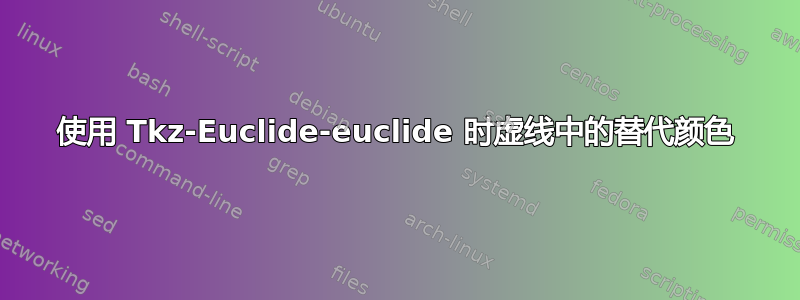
在使用 Tikz-Euclide 时,有没有办法使第三个三角形上的线变成虚线但颜色交替,从而显示出另外两个三角形彼此重叠。
\documentclass{book}
\usepackage{blindtext}
\usepackage{tikz}
\usepackage{tkz-euclide}
\usepackage{
float,
graphicx
}
% Proposition environment
\newenvironment{proposition}
{\begin{center}\em}
{\end{center}}
%Diagram enviroment
\newenvironment{diagram}
{\begin{center}\vspace*{10pt}\begin{tikzpicture}}
{\end{tikzpicture}\vspace*{-5pt}\end{center}}
\begin{document}
\begin{diagram}
\tkzDefPoint(0,0){A}
\tkzDefPoint(-2,0){B}
\tkzDefPoint(-1.5,2){C}
\tkzDefPoint(4,0){P}
\tkzDefPoint(2,0){Q}
\tkzDefPoint(2.5,2){R}
\tkzDrawPolygon[red](A,B,C)
\tkzDrawPolygon[blue](P,Q,R)
\tkzLabelPoints[right](A,P)
\tkzLabelPoints[left](B,Q)
\tkzLabelPoints[above](C,R)
\tkzMarkAngle[size=0.5](A,B,C)
\tkzMarkAngle[size=0.5](P,Q,R)
\end{diagram}
$\overline{AB} = \overline{PQ}$ given in the proposition\\
$\overline{BC} = \overline{QR}$ given in the proposition\\
$\angle{ABC} = \angle{PQR}$ given in the proposition\\
We can now superimpose the triangles onto one another with point $A$ matched with $P$, point $B$ matched with $Q$ and $C$ matched with $R$. and and with $\angle{ABC}$ matched with $\angle{PQR}$. we can say that the two triangles and \textit{congruent} with each other.
\begin{diagram}
\tkzDefPoint(0,0){A}
\tkzDefPoint(-2,0){B}
\tkzDefPoint(-1.5,2){C}
\tkzDrawPolygon(A,B,C)
\tkzLabelPoints[right](A)
\tkzLabelPoints[left](B)
\tkzLabelPoints[above](C)
\tkzMarkAngle[size=0.5](A,B,C)
\end{diagram}
\end{document}
如果有人有其他解决方案,我不必成为 Tkz-Euclide。谢谢
答案1
我认为我已经解决了这个问题,但任何改进仍然受到欢迎
\documentclass{book}
\usepackage{blindtext}
\usepackage{tikz}
\usepackage{tkz-euclide}
\usepackage{
float,
graphicx
}
% Proposition environment
\newenvironment{proposition}
{\begin{center}\em}
{\end{center}}
%Diagram enviroment
\newenvironment{diagram}
{\begin{center}\vspace*{10pt}\begin{tikzpicture}}
{\end{tikzpicture}\vspace*{-5pt}\end{center}}
\begin{document}
\begin{diagram}
\tkzDefPoint(0,0){A}
\tkzDefPoint(-2,0){B}
\tkzDefPoint(-1.5,2){C}
\tkzDefPoint(4,0){P}
\tkzDefPoint(2,0){Q}
\tkzDefPoint(2.5,2){R}
\tkzDrawPolygon[red](A,B,C)
\tkzDrawPolygon[blue](P,Q,R)
\tkzLabelPoints[right](A,P)
\tkzLabelPoints[left](B,Q)
\tkzLabelPoints[above](C,R)
\tkzMarkAngle[size=0.5](A,B,C)
\tkzMarkAngle[size=0.5](P,Q,R)
\end{diagram}
$\overline{AB} = \overline{PQ}$ given in the proposition\\
$\overline{BC} = \overline{QR}$ given in the proposition\\
$\angle{ABC} = \angle{PQR}$ given in the proposition\\
We can now superimpose the triangles onto one another with point $A$ matched with $P$, point $B$ matched with $Q$ and $C$ matched with $R$. and and with $\angle{ABC}$ matched with $\angle{PQR}$. we can say that the two triangles and \textit{congruent} with each other.
\begin{diagram}
\tkzDefPoint(0,0){A}
\tkzDefPoint(-2,0){B}
\tkzDefPoint(-1.5,2){C}
\tkzDrawPolygon[red, dash pattern= on 3pt off 5pt](A,B,C) %-------Added
\tkzDrawPolygons[blue, dash pattern = 0n 3pt off 5pt,dash phase=4pt](A,B,C)%--------Added
\tkzLabelPoints[right](A)
\tkzLabelPoints[left](B)
\tkzLabelPoints[above](C)
\tkzMarkAngle[size=0.5](A,B,C)
\end{diagram}
\end{document}


